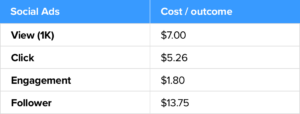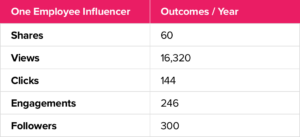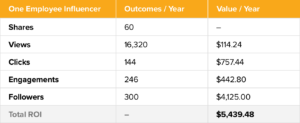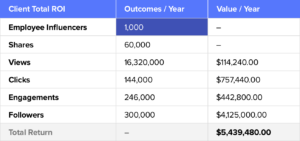There’s a saying in business that if you’re not growing, you’re dying. As a digital marketer, you’re on the front line when it comes to growth.
If you had an unlimited budget, growth wouldn’t be a problem. But you don’t have an unlimited budget and neither does anyone else. So, it’s critical that you deliver the maximum ROI for what you do have.
Chances are, you’re currently putting a large chunk/the majority of that budget toward ads. And I’m guessing that you’re spending a good percentage of that on social ads.
If you’re totally satisfied with the ROI on that spend, there’s no need to continue reading. Take a break, grab a coffee, kick up your feet. You deserve it!
However, if you’re like 99.999% of marketers who aren’t satisfied with that paid ads ROI, please read on to learn about employee influencers and why you should activate them.
When an employee shares your marketing content with their network, magical things happen. They not only generate the clicks, engagements, impressions and followers you want, but they also do so for around 1/20th the cost of an ad.
Further, every employee — no matter their rank or role — can be an influencer. Sound like something you’d like to include in your growth stack?
What’s an Employee Influencer?
An employee influencer is an employee who promotes your company on social media.
The simplest example is an employee who shares company content such as job postings, product announcements, press releases, webinars, etc. In other words, it’s the same content you already promote via paid and owned channels.
As we’ll touch on below, any employee in your company can be an influencer. Sure, your CEO may have more followers than the intern (maybe, maybe not), but EVERYONE has a network, which means they all have the ability to promote your company.
OK, let’s keep going.
Are They Different from Employee Advocates?
Employee advocates and employee influencers are one and the same.
Full transparency: We’re partially (maybe wholly) to blame for any confusion. Back in 2012 when we launched EveryoneSocial, we called these people employee advocates.
EveryoneSocial was the first employee advocacy platform on the market, and we didn’t really like the term “employee advocate.” It was and still is confusing. But it was the best we could come up with at the time.
Why didn’t we just call them employee influencers? Because the whole social media influencer thing was basically brand new at that time. And, back then, most B2B folks, especially the higher-ups, still didn’t really get social media.
But things have changed. A lot.
Those B2B higher-ups now have a much better understanding of social media. Not only do they increasingly use social media at work themselves, but they also supported the rise of social media managers, many of whom are now directors.
Regardless of a social media manager’s actual title, they have much more visibility and authority today.
Social is very much on the rise at B2B businesses. It’s more a part of a companies’ DNA than it ever has been before.
On the flipside, social media influencers in the consumer world are clearly here to stay. Globally, consumer influencers and creators generate more than $100 billion per year. And, as is often the case, success in the B2C world eventually makes its way into the B2B world.
In short, employee advocates are the same as employee influencers. But A LOT more people understand what an influencer is than know what an advocate is.
And this common knowledge is very important — especially for you and your efforts to get support for and grow an employee influencer program at your company.
The more people — in particular your leaders — who understand what it’s about, the more support you’ll garner. And, as you activate more influencers, you’ll generate more ROI.
Which Employees Can Be Influencers?
Anyone! Seriously, anyone from the intern to the CEO can be an employee influencer.
How’s that possible?
It’s very simple: Every one of your employees already has a network, and that network contains customers, prospects, partners, potential hires, etc. In fact, the average employee has more than 1,000 connections — and their networks are always expanding!
To give you an example, here at EveryoneSocial our people grew their networks by 70% over the last year!
The point is that your employees’ networks represent a giant, untapped audience. Oh, and the really cool thing? Your people WANT to be influencers. But I’m getting ahead of myself.
Why Would an Employee Want to be an Influencer?
To be blunt, success at work requires you to have a network. As one successful sales executive I know put it, “Your network is your net worth!”
If you agree with either of those statements, you should also agree with the following:
- As a professional it’s important to have a strong and growing social network.
- It’s also essential that you leverage that network to succeed in your work.
These are the reasons why your people WANT to be influencers for your company.
Even if all they do is share your marketing, recruiting, or other content, doing so helps them grow and engage their networks, which helps them succeed in their current role and creates future opportunities for themselves.
Having an official employee influencer program at your company provides direction.
Sure, some of your people are already super active on social media, but, chances are the majority aren’t. It’s not that they’re incapable or don’t have networks; it’s that they need some guidance.
And, fortunately, with a little internal support and the right tools, that’s a very easy thing to provide your people.
What Results Can They Drive?
Let’s look at the value employee influencers drive, both qualitatively and quantitatively.
First, the qualitative: Employee influencers drive marketing, sales, and recruiting outcomes because they increase the distribution of your marketing content.
They not only get it in front of a new audience (their networks), but they also get it more exposure and engagement.
When it comes to sales, your salespeople can be some of your best influencers.
There’s a direct correlation between social media use and quota attainment — in fact, 98% of sales reps meet quotas through social selling. Point being, your best salespeople are likely already active on social because they know it gives them an edge.
Activating your entire salesforce should be a top priority.
Finally, let’s talk about recruiting. If you’re hiring, you should absolutely activate your employees. Not only do people love sharing job postings and employer brand content, but empowering employee influencers will increase your candidate pipeline and quality.
Speaking from experience, we grew our team by 3x in the last year, and we couldn’t have done it without our employee influencers.
OK, now let’s talk about the quantitative. Brass tacks time.
In order to understand the value an employee influencer drives, we need a comparable, and the best comparable is social ads.
When you run an ad, you’re paying to generate an impression, click, engagement, or follower, and every company is willing to pay a different price for these outcomes.
These are some averages gleaned from EveryoneSocial clients:

These averages give us the baseline to assess the ROI an employee influencer generates.
Next, let’s look at what a single, average employee influencer will generate for over one year when they share company content with their networks.

Let’s break this down. Over the course of a year an average employee influencer will share 60 pieces of your company’s content to their network, which will generate:
- 16,320 views
- 144 clicks
- 246 engagements
Plus, the employee will gain 300 new followers (connections).
Make sense? Now let’s use our average costs per outcome to understand the value of a single employee influencer.

The takeaway: A single employee influencer generates $5,439 in value per year. Said differently, $5,439 is what you would have to pay to generate these same outcomes via ads.
Intrigued? I hope so!
Here’s what this looks like at scale. Let’s say you have 1,000 employees you want to activate. Here’s what you could expect 1,000 employee influencers to generate in a year.

1,000 employee influencers can generate $5,439,480 in value in a single year.
Have more than 1,000 employees? Great! The more you activate the bigger your return will be.
Have fewer than 1,000 employees? No problem. Employee influencer programs can work at any scale.
Should your Company have an Employee Influencer Program?
Our position is that every company can benefit from an employee influencer program. But there are some companies that can REALLY benefit from one. In loose terms, I’d describe these as high-growth companies.
High-growth companies tend to have leaders that believe in the value of social. They tend to have strong alignment among their people around driving growth (I.e., everyone, regardless of their role, sees it as their responsibility to drive growth.)
They tend to have high-performing marketing, sales, and recruiting teams who, among other things, produce great content. And, of course, these high-growth companies tend to have employees who believe in the value of social media, too.
When these conditions are present, it means you can activate your people quickly and at scale.
We’ve seen high-growth companies activate the majority of their people within just a few weeks. And as soon as you activate your people, they’re going to generate ROI.
It’s no surprise then that 31% of high-growth companies have an employee influencer program in place — more than double the average of other organizations.
What Does it Cost to Activate Employees as Influencers?
There are a few things you’re going to need to successfully activate your employees.
First, you need internal support, which comes in two forms.
The first is executive/leader support. If your leaders support social, they’re going to support an employee influencer program.
The second is you need someone (maybe this is you) to own the program. This is very often the head of social media or someone on that team.
Running an employee influencer program doesn’t need to be their full-time job. However, they will need to devote time to it — ideally, every day.
OK, assuming you have both of those things, you’re also going to need a platform.
We charge for each active employee influencer you have in your account. One of the key words there is active. We don’t charge our clients for people who aren’t active.
Said differently, we charge you only for the people who are active, not the ones who aren’t. Only charging for your active people is unique to EveryoneSocial.
And, of course, the more employees you activate on EveryoneSocial, the better the pricing gets. In terms of budget, it all depends on your organization’s size.
Should you want a quote based on your company and plans, please reach out. We’d be happy to prepare one for you.
What Are the Risks?
In the early years of employee advocacy, people would often ask “What if someone shares something they shouldn’t?”
Fortunately the risk with employee influencers is little to none. No more than anything else your social media team is already doing (probably less).
The first thing to consider is that some of your people are already active on social media professionally. In fact, 98% of employees use at least one social media site, and 50% of those workers already post about their company.
Do you know who these people are? Do you know what they’re sharing? Chances are the answer is somewhere between “maybe” and “no.”
Having an official employee influencer program provides a single tent for everyone to get under though — a tent where you not only define the rules, but where you also have visibility over everything. This includes what’s approved for sharing vs. what isn’t, what people are sharing, where they’re sharing it to, and more.
The second thing to consider with risk is that it’s not in anyone’s interest to do “something bad.”
We’ve never seen an employee influencer share something they shouldn’t, and I don’t believe we ever will.
For one, you’ve taken great care to hire the best possible people to represent your company, and you should trust them to do so. Trust is huge.
Further and unlike with consumer social where anything goes, people aren’t who they say they are, etc., when it comes to using social in a professional context, everyone is inherently a good actor.
No one wants to look like a bozo or get fired for something they shared. Using social media as a professional is about success! But, of course, guardrails are helpful, which is where EveryoneSocial comes in.
Some of our customers require a lot of control because they’re in a regulated industry — I’m talking about companies in financial services and healthcare, for example.
However, other customers want to exert very little control and leave most of the decisions up to their people, which is awesome.
No matter where you fall on that spectrum, EveryoneSocial gives you the tools you need.
What Tools Do You Need?
At the highest level, we believe you need two things:
- A platform your people want to use
- A partner to support you along your journey
To the first point, it’s no one’s job to be an employee influencer — they have to want to. And giving them a platform that’s easy and enjoyable to use is critical for that.
The foundation of your influencer program is based on your people’s engagement and how many of them use the platform on a monthly basis.
Like any good software product, it needs to bring people back, entice them to take action, and clearly communicate the value users generate for themselves.
Two of the top three Fortune 100 companies use EveryoneSocial. One of them is Amazon, and the other doesn’t like their name mentioned. 🍇
EveryoneSocial is also used by many smaller, high-growth companies, including Qualtrics, Unity, Cloudera, Okta, and Highspot, just to name a few.
To the second point, we’ve worked with a lot of companies on their influencer programs. And while every company and program is different, with our experience and track record of success we’re in a great position to be your guide and get you up and running and generating ROI in the shortest possible time.
We don’t believe anyone wants to buy software — they want to buy SUCCESS! That’s why we fully partner with every EveryoneSocial client. We want to be on the same side of the table, working together to ensure every user’s success.
This is why we’ve invested so heavily in our client-experience team, which includes dedicated resources for the following:
- Implementation: a team dedicated to ensuring successful program launches
- Account management: your primary POC dedicated to your account
- Support: support for your program managers and users
- Managed services: resources to supplement your own in-house team
Ready, Set, Activate
First off, if you’ve made it this far, congratulations — clearly, I had a lot to say on this topic. 😊
Second, hopefully you’ve come to the same conclusion we have: that you’d be crazy not to activate your employees as social media influencers!
If you’re responsible for driving marketing, sales, or recruiting, this is going to be one of the highest ROI initiatives you invest in. Many of the world’s leading companies already activate their employees as influencers, and it’s not too late for you to get in the game.
But as the saying goes, the early bird gets the worm, so time is of the essence if you want your employee influencers to have the greatest impact
Where do you go from here? Reach out to our team to schedule a call or create an account for yourself and start activating your people!
Thanks for your time and don’t hesitate to reach out if you have any questions. Again, our #1 priority is ensuring your success.
















